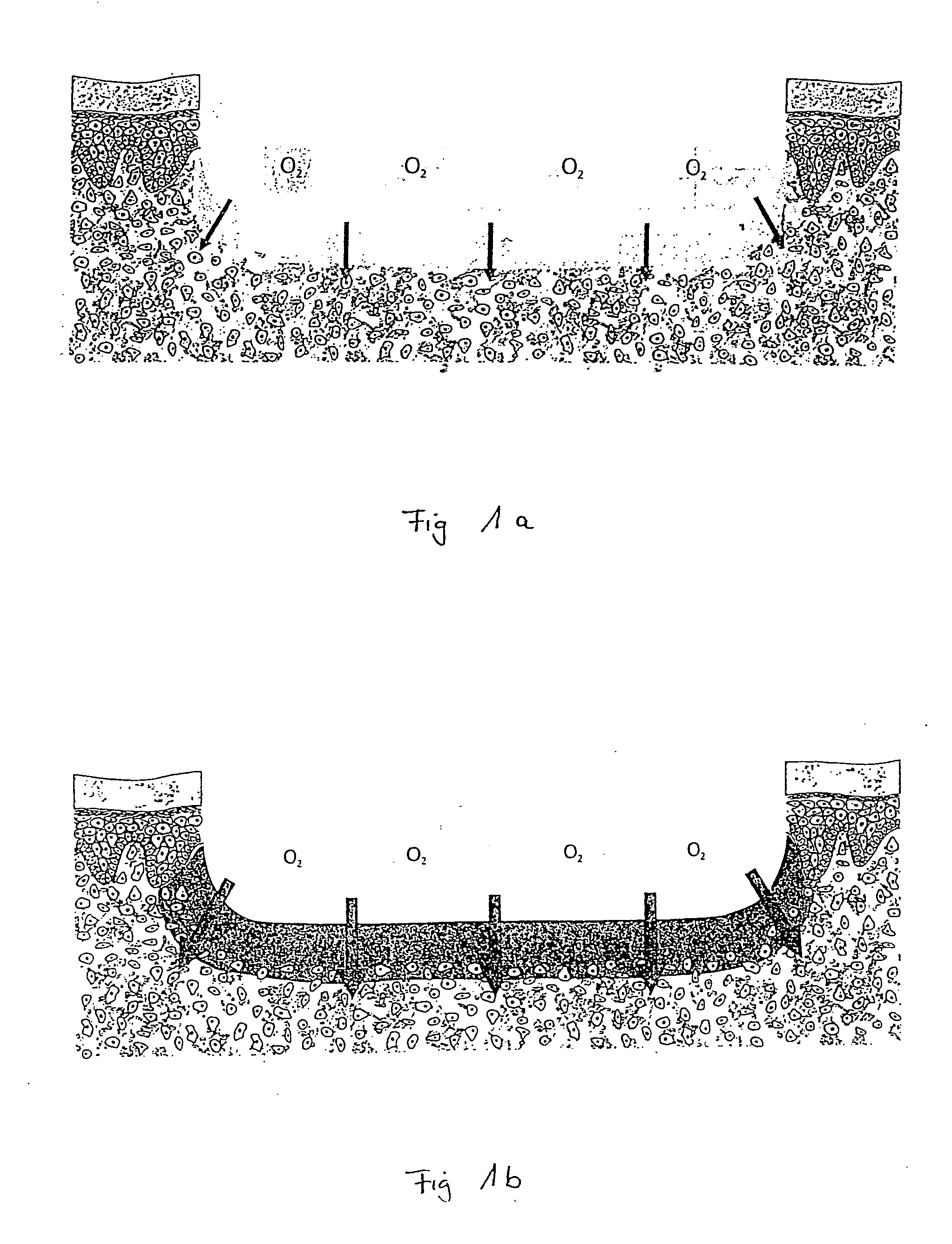Use of one or more natural or modified oxygen carriers, devoid of plasma and cellular membrane constiuents, for externally treating open, in particular chronic wounds
a technology of oxygen carrier and cellular membrane, which is applied in the field of external treatment of open wounds, can solve the problems of high toxicity of oxygen, deficiency of oxygen (hypoxia), and deficiency of plasma and cellular membrane constiuents,
- Summary
- Abstract
- Description
- Claims
- Application Information
AI Technical Summary
Problems solved by technology
Method used
Image
Examples
example 1
[0040] Human natural hemoglobin was freed from plasma and cellular membrane constituents by means of centrifugation and ultrafiltration, and purified.
[0041] Of this, 8 wt.-%, as well as 5 wt.-% glucose and 20 IU / ml insulin, were dissolved in 100 ml water, containing 0.9 wt.-% sodium chloride.
example 2
[0042] Highly pure porcine hemoglobin, in a concentration of 330 g / L, dissolved in an electrolyte having the composition 50 mM NaHCO3 and 100 mM NaCl, was deoxygenated at 4° C. by stirring the solution while constantly renewing the pure nitrogen atmosphere above the solution. Subsequently, 4 mol sodium ascorbate (as a 1 molar solution in water) was added per mol (monomer) hemoglobin, and this was allowed to react for 6 h. The solution was titrated to a pH of 7.1 with 0.5 molar lactic acid, 1.1 mol pyridoxal-5′-phosphate per mol hemoglobin was added, and this was allowed to react for 16 h. Now a pH of 7.8 was adjusted with 0.5 molar soda lye, 1.1 mol sodium borhydride (as a 1 molar solution in 0.01 molar soda lye) was added, and this was allowed to react for one hour. Now a pH of 7.3 was adjusted with 0.5 molar lactic acid, then 1.1 mol 2,3-bisphosphoglycerate per mol hemoglobin and, after 15 min reaction time, 8 mol glutardialdehyde per mol hemoglobin, dissolved in 1.8 L pure water,...
example 3
[0046] Synthesis of human hemoglobin cross-linked with glutardialdehyde took place as in Example 2, but using highly pure, concentrated human hemoglobin and using a 16 times molar excess of the cross-linking agent. Polymers were obtained by means of fractionation of the solution of the cross-linking products using preparative volume exclusion chromatography (in accordance with EP-A 95 10 72 80.0: “Verfahren zur Herstellung molekular-einheitlicher hyperpolymerer Hämoglobine” [Method for the production of molecular-uniform hyperpolymer hemoglobins] with Sephacryl S-300 HR gel, Pharmacia Biotech, Freiburg, Germany) (here, as the first eluted 57 mass-% of the cross-linked hemoglobin).
[0047] The cross-linked hemoglobins were divided into two parts, A and B. The hemoglobin A (compare FIG. 3) proved to be predominantly polymer hemoglobin having a modal value of the molecular weight distribution of 950 kg / mol (compare Example 1). Covalent binding of monofunctionally active mPEG-SPA-1000 to...
PUM
| Property | Measurement | Unit |
|---|---|---|
| diffusion distance | aaaaa | aaaaa |
| distance | aaaaa | aaaaa |
| critical length | aaaaa | aaaaa |
Abstract
Description
Claims
Application Information
 Login to View More
Login to View More - R&D
- Intellectual Property
- Life Sciences
- Materials
- Tech Scout
- Unparalleled Data Quality
- Higher Quality Content
- 60% Fewer Hallucinations
Browse by: Latest US Patents, China's latest patents, Technical Efficacy Thesaurus, Application Domain, Technology Topic, Popular Technical Reports.
© 2025 PatSnap. All rights reserved.Legal|Privacy policy|Modern Slavery Act Transparency Statement|Sitemap|About US| Contact US: help@patsnap.com

